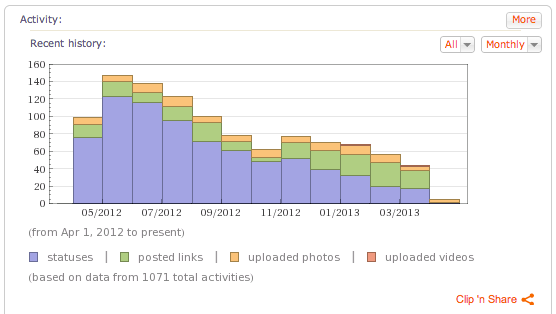My guess is that you manage to accumulate piles of paper in your office, in your home, or maybe even in your car (I accumulate paper in all three places). At least once a year I attempt to get to the bottom of these stacks and put everything away (this creates clean space to begin accumulating new stacks!). The goal of file organization would be to create a system for organizing these “stacks” that is so natural to use, that it’s just as easy to put away the paper as it is to stack the papers.
Ironically, sometimes the best way to find that natural system of organization is to first accumulate a “stack.” After looking through all the crap stuff you accumulate over a period of time, you can start to get a sense for what the natural categorization is. Sort the “stack” into smaller stacks, and group those according to theme, and re-sort if necessary.
On a computer, we accumulate these “paper stacks” in a slightly different form … files. If you’ve been accumulating random files on your desktop, or in a folder labeled “Junk”, then I would like to congratulate you on your forward thinking. You were obviously just gathering these together to help you establish a natural computer file organization system.
Your mission, should you choose to accept it: Restructure all the really important files you regularly access, plus all those miscellaneous files you’ve been accumulating in computer piles, into (at most) ten file folders. Bonus points for you if you install a sync / backup for these ten folders while you’re at it.
Why 10 and not more than 10? You need to have a small enough group of folders that you can see all of them at once. It needs to be a short enough list that you remember and regularly use all the folders in the list. Why? Because if you don’t regularly use a folder, you’ll forget you have it and end up creating a duplicate folder (or subfolder) to gather files. This might not seem horribly problematic, but as you start to split the files into two locations, you’ll start to lose track of where you’ve put things.
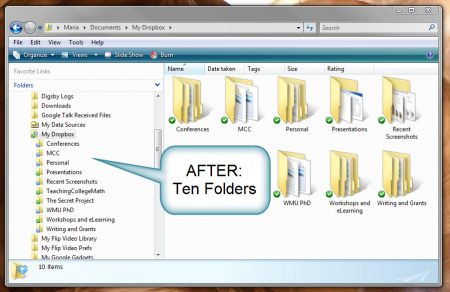
If your computer has been accumulating files for as long as mine has, you’ll need some ground rules to get started on the herculean task or organizing those unruly files.
- Create as many sorting folders as you want to at first. Every time you find at least five related items, put them in a folder together. These folders may eventually turn out to be subfolders of some larger category, but for now, just sort.
- Don’t open the files. Create temporary storage folders called Unfiled. and No Idea. This initial sort is a little like that first sort on the show Clean Sweep. It’s not the time to worry about perfectly sorting every file. When you honestly have no idea what a file is, put it in No Idea. If you know you should keep it, but you don’t know how to categorize it, put it in Unfiled. You may also use Unfiled when you just get tired of sorting, and want to just throw everything left into a folder. As files begin to accumulate in the Unfiled folder, you’ll find that they start to group together naturally into categories.
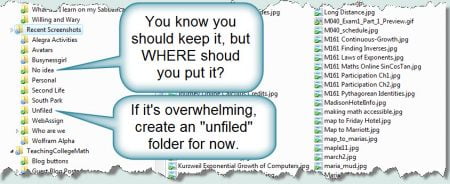
There are some visual ways to make file-sorting easier. For example, you can change the way you view the files. For some types of files (document files), it’s probably easier to see them in a list view. For other types of files (images), icons are preferable for easy sorting.
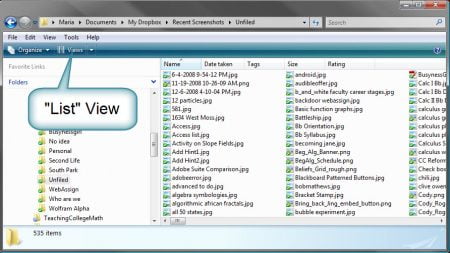
![]()
In the Detail View, you can click on the column headers to sort (ascending or descending) by that property.

When you’re done with the primary sort, you should have a collection of miscellaneous folders. Now you have to look for ways to organize those folders into larger, all-encompassing categories.
I found that I had a lot of folders with specific conference information (proposals, acceptance letters, travel requests, presentations, and notes), so I created a superfolder called Conferences to house all those smaller folders. Each subfolder is then relabeled in a way that makes them easy to find. In this case, it’s the name of the conference, year, and location.
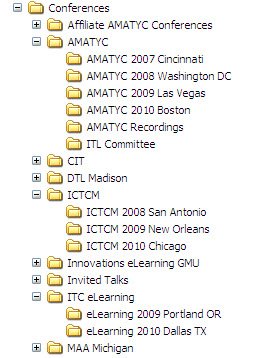
I’m not going to lie … this task is likely going to take you a while. However, if you’re like me, it’s been on your list of things to do (aka “things you’ll never get to”) for a while. Well, there’s no time like the present. And, you can say that I ordered you to do it!
Don’t get caught up into the black hole of opening files and cleaning up the files themselves. For example, I had to resist the urge to create a database of all my test questions. I also had to resist the urge to rename all the files in a similar format. Just don’t go there! At least … not this week. All you do this week is sort.
When you’re completely done with your 10-folder mission, consider making this the time in your life to sync your computer systems once and for all. A good syncing program will also create an automatic backup system for your important files. Let me see if I can explain (easily) how a sync works.
I have two computers: Home and Work. I’d also want an Internet backup so that (a) I have copies of files if anything happens to the computers and (b) I can access the files from someone else’s computer if necessary. I pay for a program called Dropbox. On each computer, there is a “My Dropbox” folder with the exact same set of files. This “My Dropbox” folder is also on the Internet (accessed with a username & password). When I make a change to a file on my home computer, it syncs this change to the Internet, and the next time my work computer is on, it picks up the change and saves it on that computer too. It’s not the entire computer that’s synced, it’s just this particular folder. There are some kinds of files that you may not want to sync (i.e. personal financial information, student grades, etc.). Just leave these files in a folder outside of the dropbox.
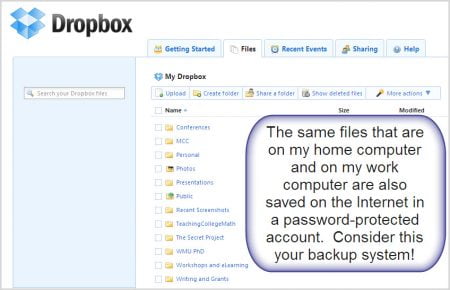
What’s the real advantage of a sync between computers? No more duplicate files. You will never again open a file, only to discover that it’s the version from several weeks ago instead of yesterday’s version. That’s just awesome.
One word of caution. Once you have a sync established, tackle the file sorting at a reasonable pace (go for 15 minutes at a time, instead of a massive 4-hour sorting session). If you sort and rename too many files too fast, your sync (on multiple machines) may not be able to keep up with you (or, ignore my advice and learn this the hard way).
So, find those orphaned files, and give yourself 15 minutes every day to do nothing but sort those files.
This is just the tip of the digital decluttering iceberg.




